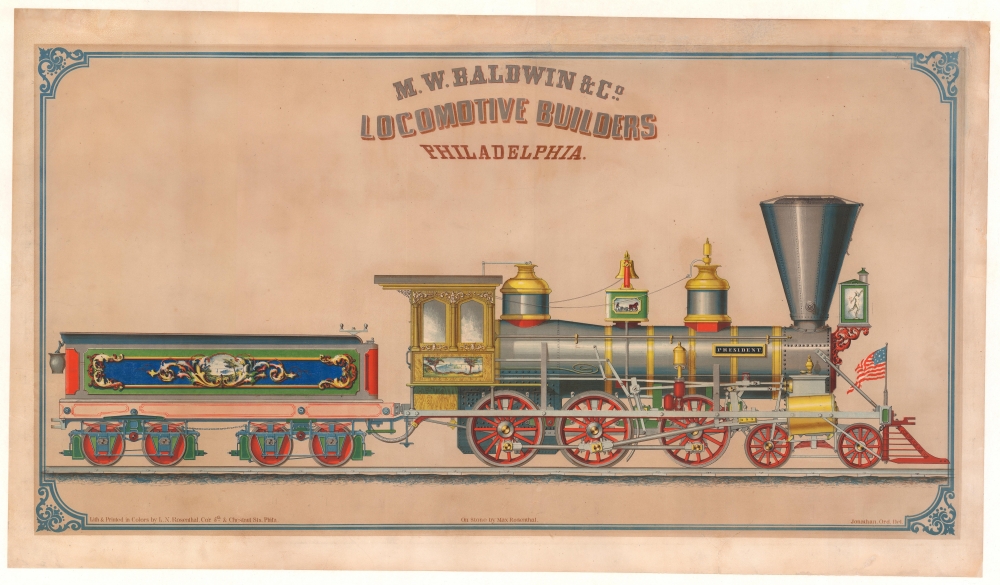1860 Ord Lithograph of 'President' Steam Locomotive
PresidentLocomotive-ord-1860
Title
1860 (undated) 20.5 x 38 in (52.07 x 96.52 cm)
Description
A Closer Look
Chromolithographed bright colors, the locomotive features an ornate headlamp and bright red cattle catcher. Painted panels adorn the headlamp, the bell, and the train's cab. Filigree also decorates the bright yellow cab. The tender is painted green, blue, red, and yellow, and also features a beautifully painted panel.The Baldwin Locomotive Works
The Baldwin Locomotive Works was founded by Matthias W. Baldwin in Philadelphia in 1825 and moved to Eddystone, Pennsylvania in the early 20th century. It was the world's largest producer of steam locomotives for decades, producing over 70,000 between its founding and 1951, when it merged with the Lima-Hamilton Corporation.Chromolithography
Chromolithography, sometimes called oleography, is a color lithographic technique developed in the mid-19th century. The process involved using multiple lithographic stones, one for each color, to yield a rich composite effect. The process often began with a black basecoat upon which subsequent colors were layered. Some chromolithographs used 30 or more separate lithographic stones to achieve the desired effect. Chromolithograph color could also be blended for even more dramatic results. The process became popular in the late 19th and early 20th centuries, when it emerged as the dominant method of color printing. The vivid color chromolithography produced made it exceptionally effective for advertising and propaganda.Publication History and Census
This piece was drawn by Jonathan Ord, engraved on stone by Max Rosenthal, and lithographed and printed by L. N. Rosenthal c. 1860. We have not located any examples in institutional collection and have discovered only one instance in recent years when this piece has appeared on the private market.CartographerS
Max Rosenthal (November 22, 1833 - August 8, 1918) was a lithographer and engraver active in Philadelphia during the mid to late 19th century. Born in Turck, Russian Poland, Rosenthal was one of five brothers (Louis, Solomon, Morris, and Simon). He and all his brothers left Poland at the behest of their father to avoid being drafted into the army. Louis and Simon were sent to London to apprentice with a lithographer, Max went to Paris to study with artist and lithographer Martin Thurwanger at the age of thirteen, and Morris went to Rabbinical School in Berlin, Germany. Thurwanger (Max's teacher) had a contract with the Smithsonian Institution in the late 1840s went to the United States and Max went with him. By 1849 Max had arrived in Philadelphia and worked under contract for Dubal and Company. He also studied at the Pennsylvania Academy of Fine Arts. Around 1851 after completing his work at the Academy, Max partnered with his brother Louis to set up a lithography firm in Philadelphia known either as L.N. Rosenthal or simply Rosenthals. It appears Max became the firm's primary artist, with Louis running the establishment and acting as publisher. The firm published sheet music covers, portraits, maps, labels, advertisements, building views, and anatomical and geological charts. Max created a series of camp and battle scenes during the American Civil War while traveling with the Grand Army of the Potomac from 1861 to 1863 that Rosenthals published. Rosenthals relocated twice throughout the 1850s and 1860s and was located at 327 Walnut Street when the firm burned and suffered severe water damage. After the fire, the firm closed and Louis moved to Chicago, where he worked as a lithographer and printer, but Max stayed in Philadelphia. Max continued working as an artist and lithographer, along with his son Albert (1863 - 1939) in Philadelphia until the 1910s. Max was an instructor for the Art Students Union later in life and experimented with mezzotint engraving. He also produced oil and watercolor paintings. Max married Caroline during the 1850s and with whom he had at least seven children. More by this mapmaker...
Louis N. Rosenthal (c. 1824 - after 1900) was a lithographer active in Philadelphia and Chicago during the mid to late 19th century. Born in Turck, Russian Poland, Rosenthal was one of five brothers (Max, Solomon, Morris, and Simon). He and all his brothers left Poland at the behest of their father to avoid being drafted into the army. Louis and Simon were sent to London to apprentice with a lithographer, Max went to Paris to study with artist and lithographer Martin Thurwanger, and Morris went to Rabbinical School in Berlin, Germany. Louis arrived in New York on September 29, 1848, after his apprenticeship in London ended. He was an established member of the lithographic trade in Philadelphia by the following year and was part of a brief partnership with Peter Kramer in 1850. Thurwanger (Max's teacher) had a contract with the Smithsonian Institution in the late 1840s went to the United States and Max went with him. Max and Louis set up a lithography firm in Philadelphia in 1851 known either as L.N. Rosenthal or simply Rosenthals. It appears Max became the firm's primary artist, with Louis running the establishment and acting as publisher. The firm published sheet music covers, portraits, maps, labels, advertisements, building views, anatomical and geological charts, and Civil War scenes. Rosenthals relocated twice throughout the 1850s and 1860s and was located at 327 Walnut Street when the firm burned and suffered severe water damage. After the fire, the firm closed and Louis moved to Chicago, where he worked as a lithographer and printer until his death sometime after 1900. By 1850, Louis was married to Louisa, with whom he had eight children. Learn More...

